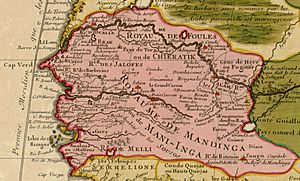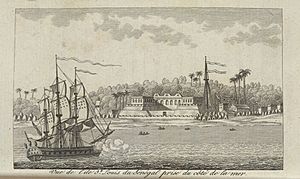British capture of Senegal facts for kids
Quick facts for kids British capture of Senegal |
|||||||
|---|---|---|---|---|---|---|---|
| Part of Seven Years' War | |||||||
 A map of depecting the various kingdoms of Senegambia in 1707, by Guillaume Delisle. In the 18th century, France only controlled the city of Saint-Louis and the island of Gorée. |
|||||||
|
|||||||
| Belligerents | |||||||
| Commanders and leaders | |||||||
| Henry Marsh James Sayer |
|||||||
| Strength | |||||||
| 200 marines Light artillery 6 Royal Navy vessels: * HMS Harwich * HMS Nassau * HMS Rye (1745) * HMS Swan (1745) * HMS London (1756) * HMS Portsmouth (1756) 5 hired armed vessels |
232 officers and soldiers 92 guns A brig 6 sloops |
||||||
The British capture of Senegal happened in 1758 during the Seven Years' War with France. It was part of a bigger plan by the British to make France weaker. They wanted to hurt France's economy by stopping its international trade.
To do this, small British military groups landed in Senegal. They captured Gorée and Fort Saint Louis. This was a French trading post located at Saint-Louis. The British also took French ships and supplies. By late 1758, the British had captured the entire French colony on the Senegalese coast. Lieutenant Colonel Richard Worge became the first British Governor of Senegal.
Why the British Attacked Senegal
The idea for this attack came from American merchant Thomas Cumming. He had visited West Africa before. He thought a British expedition there could work well. His plan used Britain's growing strength on the oceans. This strength had greatly reduced France's sea power (control of the seas).
A British naval force, led by Captain Henry Marsh, would sail from England. They would go to the coast of West Africa. There, they would land an amphibious force near the Senegal River. An amphibious force can fight on both land and water. Their goal was to capture the French fort at Saint-Louis. Cumming also planned to get help from local African groups. These groups would meet the British and attack the French.
The French settlements in Senegal were not very important for military reasons. But they were very important for France's worldwide trade in valuable goods. They also had a big industry for natural gums. So, the main goal of the expedition was to hurt the French economy. This would stop France from getting money from these industries. This type of attack was part of William Pitt's plan. Pitt was a powerful British leader, like a Secretary of State. He wanted to destroy France's ability to keep fighting the war by cutting off their money.
The Expedition to Senegal
Two hundred soldiers and two warships were part of this mission. The forces left Plymouth in early 1758. After a quick stop for supplies at Tenerife, they reached West Africa in April.
Cumming had gone ashore to get support from local people. These local groups then created a blockade around the fort on the land side. Captain Marsh then landed his troops. The French soldiers at the fort were completely surprised by the sudden arrival of the British. On May 1, the French gave up the fort. The traders living there promised to be loyal to the British. Not a single British soldier was killed during the capture of Saint-Louis.
Cumming's ships returned home full of captured goods. These goods were worth hundreds of thousands of pounds. Pitt was very happy that the British had taken Saint-Louis so easily. He was also impressed by the large amount of Gum arabic brought back to Britain. This gum was much cheaper for people who made silk.
Because this mission was so successful, two more expeditions were sent out that year. These expeditions captured the Island of Gorée and the French trading post on the Gambia. Pitt wanted to launch even more expeditions. But he faced opposition from the Duke of Newcastle. The Duke was worried that taking too many troops from the British Isles would leave them open to invasion.
What Happened Next
The capture of Senegal, along with attacks on Canada, the West Indies, and the Philippines, showed how far the Royal Navy could reach. It also showed that European conflicts were becoming global. Because of this, historians have called the Seven Years' War the first "world war."
Who owned the West African lands became a big point of disagreement. This happened between Britain and France during the peace talks. These talks led to the 1763 Treaty of Paris. The discussions focused on giving back some of the captured places. Britain wanted to keep the Senegalese mainland. But they were willing to give back Gorée. In the end, Britain kept Saint-Louis and the Senegal mainland. These became part of British Senegambia.
The British planned to increase their presence in West Africa. They wanted to use Senegal as a starting point. To protect their new land, they created the Africa Corps. This was a special unit of troops led by Charles O'Hara. The French were not happy about losing this valuable colony. They planned to get it back.
In 1764, the French attacked the coast of Senegal from Gorée. This made the British government angry. In 1779, during the American Revolutionary War, a French force landed and took Saint-Louis. Senegal was given back to France by Britain as part of the Treaty of Paris. This treaty ended the war in 1783. French control remained unsteady until they finally left in 1852.
See also


